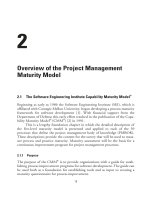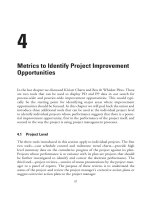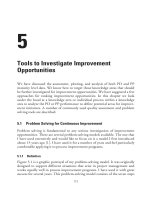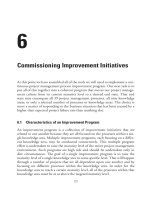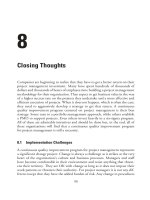Process Improvement
Bạn đang xem bản rút gọn của tài liệu. Xem và tải ngay bản đầy đủ của tài liệu tại đây (99.92 KB, 16 trang )
©Ian Sommerville 2004 Software Engineering, 7th edition. Chapter 28 Slide 1
Process Improvement
©Ian Sommerville 2004 Software Engineering, 7th edition. Chapter 28 Slide 2
To explain the principles of software process
improvement
To explain how software process factors
influence software quality and productivity
To explain how to develop simple models of
software processes
To explain the notion of process capability
and the CMMI process improvement model
Objectives
©Ian Sommerville 2004 Software Engineering, 7th edition. Chapter 28 Slide 3
Process and product quality
Process classification
Process measurement
Process analysis and modelling
Process change
The CMMI process improvement framework
Topics covered
©Ian Sommerville 2004 Software Engineering, 7th edition. Chapter 28 Slide 4
Understanding existing processes and
introducing process changes to improve
product quality, reduce costs or accelerate
schedules.
Most process improvement work so far has
focused on defect reduction. This reflects the
increasing attention paid by industry to
quality.
However, other process attributes can also
be the focus of improvement
Process improvement
©Ian Sommerville 2004 Software Engineering, 7th edition. Chapter 28 Slide 5
Process attributes
Process
characteristic
Description
Understandability To what extent is the process explicitly defined and how easy is it t o
understand the process definition?
Visibility Do the process activities culminate in clear results so that the progress
of the process is externally visible?
Supportability To what extent can CASE tools be used to support the process
activities?
Acceptability Is t he defined process acceptable to and usable by the engineers
responsible for producing the software product?
Reliability Is the process designed in such a way that process errors are avoided or
trapped before they result in product errors?
Robustness Can the process continue in spite of unexpected problems?
Maintainability Can the process evolve to reflect changing organisational requirements
or identified process improvements?
Rapidity How fast can the process of delivering a system from a given
specification be completed?
©Ian Sommerville 2004 Software Engineering, 7th edition. Chapter 28 Slide 6
The process improvement cycle
Analyse
Measure
Change
©Ian Sommerville 2004 Software Engineering, 7th edition. Chapter 28 Slide 7
Process measurement
• Attributes of the current process are
measured. These are a baseline for
assessing improvements.
Process analysis
• The current process is assessed and
bottlenecks and weaknesses are identified.
Process change
• Changes to the process that have been
identified during the analysis are introduced.
Process improvement stages
©Ian Sommerville 2004 Software Engineering, 7th edition. Chapter 28 Slide 8
Process quality and product quality are closely
related and process improvement benefits arise
because the quality of the product depends on its
development process.
A good process is usually required to produce a
good product.
For manufactured goods, process is the
principal quality determinant.
For design-based activity, other factors are also
involved especially the capabilities of the designers.
Process and product quality
©Ian Sommerville 2004 Software Engineering, 7th edition. Chapter 28 Slide 9
Principal product quality factors
Product
quality
Development
technolo gy
Cost, time and
schedule
Process
quality
People
quality
©Ian Sommerville 2004 Software Engineering, 7th edition. Chapter 28 Slide 10
Quality factors
For large projects with ‘average’ capabilities,
the development process determines
product quality.
For small projects, the capabilities of the
developers is the main determinant.
The development technology is particularly
significant for small projects.
In all cases, if an unrealistic schedule is
imposed then product quality will suffer.
©Ian Sommerville 2004 Software Engineering, 7th edition. Chapter 28 Slide 11
Informal
• No detailed process model. Development team chose
their own way of working.
Managed
• Defined process model which drives the development
process.
Methodical
• Processes supported by some development method such
as the RUP.
Supported
• Processes supported by automated CASE tools.
Process classification
©Ian Sommerville 2004 Software Engineering, 7th edition. Chapter 28 Slide 12
Process applicability
Prototypes
Shor t-lifetime systems
4GL business systems
Small/medium-sized
systems
Infor mal
process
Large systems
Long-lifetime pr oducts
Mana ged
process
Well-understood
applica tion domains
Re-eng ineer edsystems
Methodical
process
©Ian Sommerville 2004 Software Engineering, 7th edition. Chapter 28 Slide 13
Process used should depend on type of
product which is being developed
• For large systems, management is usually the principal
problem so you need a strictly managed process;
• For smaller systems, more informality is possible.
There is no uniformly applicable process which
should be standardised within an organisation
• High costs may be incurred if you force an inappropriate
process on a development team;
• Inappropriate methods can also increase costs and lead
to reduced quality.
Process choice
©Ian Sommerville 2004 Software Engineering, 7th edition. Chapter 28 Slide 14
Process tool support
Informal
process
Mana ged
process
Methodical
process
Improving
process
Specialis ed
tools
Analysis and
design
wor kbenches
Project
mana gement
tools
Configur ation
mana gement
tools
Generic
tools
©Ian Sommerville 2004 Software Engineering, 7th edition. Chapter 28 Slide 15
Wherever possible, quantitative process data
should be collected
• However, where organisations do not have clearly defined
process standards this is very difficult as you don’t know
what to measure. A process may have to be defined
before any measurement is possible.
Process measurements should be used to
assess process improvements
• But this does not mean that measurements should drive
the improvements. The improvement driver should be the
organizational objectives.
Process measurement
©Ian Sommerville 2004 Software Engineering, 7th edition. Chapter 28 Slide 16
Time taken for process activities to be
completed
• E.g. Calendar time or effort to complete an
activity or process.
Resources required for processes or
activities
• E.g. Total effort in person-days.
Number of occurrences of a particular event
• E.g. Number of defects discovered.
Classes of process measurement
©Ian Sommerville 2004 Software Engineering, 7th edition. Chapter 28 Slide 17
Goals
• What is the organisation trying to achieve? The
objective of process improvement is to satisfy
these goals.
Questions
• Questions about areas of uncertainty related to
the goals. You need process knowledge to
derive these.
Metrics
• Measurements to be collected to answer the
questions.
Goal-Question-Metric Paradigm
©Ian Sommerville 2004 Software Engineering, 7th edition. Chapter 28 Slide 18
Process analysis and modelling
Process analysis
• The study of existing processes to understand
the relationships between parts of the process
and to compare them with other processes.
Process modelling
• The documentation of a process which records
the tasks, the roles and the entities used;
• Process models may be presented from
different perspectives.



